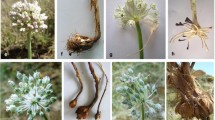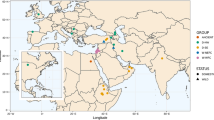Abstract
The domestication of tetraploid wheats started from their wild progenitor Triticum dicoccoides. In this paper, the geographical distribution of this progenitor is revised to include more sampling locations. The paper is based on a collection of wild and domesticated lines (226 accessions in total) analyzed by AFLP at 169 polymorphic loci. The collection includes the 69 wild lines considered by Mori et al. (2003) in their study on chloroplast DNA haplotypes of T. dicoccoides. The goal of the experiment was to reconsider which location thought to have generated the domesticated germplasm has the highest chance of being the actual site from which wild progenitors were sampled during domestication. Phylogenetic analysis of the nuclear AFLP databases indicates that two different genetic taxa of T. dicoccoides exist, the western one, colonizing Israel, Syria, Lebanon and Jordan, and the central-eastern one, which has been frequently sampled in Turkey and rarely in Iran and Iraq. It is the central-eastern race that played the role of the progenitor of the domesticated germplasm. This is supported by the cumulative results of the AFLP data from the collections of Ozkan et al. (2002) and of Mori et al. (2003), which indicate that the Turkish Karacadag population, intermixed with some Iraq-Iran lines, has a tree topology consistent with that of the progenitor of domesticated genotypes. The Turkish Kartal population belongs genetically to the central-eastern T. dicoccoides race but at the nuclear DNA level is less related to the domesticated gene pool. A general agreement between published work on tetraploid wheat domestication emerges from these results. A disagreement is nevertheless evident at the local geographical scale; the chloroplast DNA data indicate the Kartal mountains while AFLP fingerprinting points to the Karacadag Range as the putative site of tetraploid wheat domestication.

Similar content being viewed by others
References
Badr A, Muller K, Schafer-Pregl R, El Rabey H, Effgen S, Ibrahim HH, Pozzi C, Rohde W, Salamini F (2000) On the origin and domestication history of barley. Mol Biol Evol 17:499–510
Bar-Yosef O (1998) The natufian culture in the Levant, threshold of the origin of agriculture. Evol Anthropol 6:159–177
Cavalli-Sforza LL, Edwards AWF (1967) Phylogenetic analysis: models and estimation procedures. Evolution 32:550–570
Cavalli-Sforza LL, Piazza A (1975) Analysis of evolution: evolutionary rates, independence and treeness. Theor Popul Biol 8:127–165
Cavalli-Sforza LL, Menozzi P, Piazza A (1994) The history and geography of human genes. Princeton University Press, Princeton
Doyle JJ, Lucknow M (2003) The rest of the iceberg: legume diversity and evolution in a phylogenetic context. Plant Physiol 131:900–910
Dvorak J, Di Terlizzi P, Zhang HB, Resta P (1993) The evolution of polyploid wheats: identification of the A genome donor species. Genome 36:21–31
Dvorak J, Luo MC, Yang ZL, Zhang HB (1998) The structure of the Aegilops tauschii gene pool and the evolution of hexaploid wheat. Theor Appl Genet 67:657–670
Felsenstein J (1981) Evolutionary trees from DNA sequences: a maximum likelihood approach. J Mol Evol 17:368–371
Felsenstein J (1989) PHYLIP - Phylogeny Inference Package (v3.2). Cladistics 5:164–166
Fitch WM, Margoliash E (1967) Construction of phylogenetic trees. Science 155:279–284
Gaut BS, Morton BR, McCaig BC, Clegg MT (1996) Substitution rate comparisons between grasses and palms: synonymous rate differences at the nuclear gene Adh parallel rate differences at the plastid gene rbcL. Proc Natl Acad Sci USA 93:10274–10279
Gopher A, Abbo S, Lev-Yadun S (2002) The “when”, the “where” and the “why” of the Neolithic revolution in the Levant. Doc Praehist 28:1–14
Harlan JR, Zohary D (1966) Distribution of wild wheats and barley. Science 153:1074–1080
Heun M, Schaefer-Pregl R, Klawan D, Castagna R, Accerbi M, Borghi B, Salamini F (1997) Site of Einkorn wheat domestication identified by DNA fingerprinting. Science 278:1312–1314
Jaccard P (1908) Nouvelle recherches sur la distribution florale. Bull Soc Vaud Sci Nat 44:223–270
Johnson BL (1975) Identification of the apparent B-genome donor of wheat. Can J Genet Cytol 17:21–39
Kislev ME (1980) Triticum parvicoccum sp. nov., the oldest naked wheat. Israel J Bot 28:95–107
Lev-Yadun S, Gopher A, Abbo S (2000) The cradle of agriculture. Science 288:1602–2603
Maier U (1996) Morphological studies of free-threshing wheat ears from a Neolithic site in southwest Germany, and the history of naked wheats. Veget Hist Archaeobot 5:39–55
McDade LA, Masta SE, Moody ML, Waters E (2000) Phylogenetic relationship among Acanthaceae: evidence from two genomes. Syst Bot 25:106–121
Moore AMT, Hillman GC, Legge AJ (2000) Village on the Euphrates. Oxford University Press, Oxford
Mori N, Ishii T, Ishido T, Hirosawa S, Watatani H, Kawahara T, Nesbitt M, Belay G, Takumi S, Ogihara Y, Nakamura C (2003) Origin of domesticated emmer and common wheat inferred from chloroplast DNA fingerprinting. 10th International Wheat Genetics Symposium, 1–6 September 2003, Paestum, Italy, pp 25–28
Nei M (1972) Genetic distance between populations. Am Naturalist 106:283–292
Nesbitt M, Samuel D (1996) From staple crop to extinction? The archaeology and history of the hulled wheats. In: Padulosi S, Hammer K, Heller J (eds) Hulled wheats. Proceedings of the 1st international workshop on hulled wheats, pp 41–100
Nesbitt M, Samuel D (1998) Wheat domestication: archaeological evidence. Science 279:1433
Ozkan H, Brandolini A, Schafer-Pregl R, Salamini F (2002) AFLP analysis of a collection of tetraploid wheats indicates the origin of emmer and hard wheat domestication in southeast Turkey. Mol Biol Evol 19:1797–1801
Rao PS, Smith LE (1968) Studies with Israel and Turkish accessions of Triticum L. emend. Var. dicoccoides (KORN) BOWDEN. Wheat Inform Serv 26:6–7
Reynolds JB, Weir BS, Cockerham CC (1983) Estimation of the coancestry coefficient: basis for a short-term genetic distance. Genetics 105:767–779
Rohlf FJ (1998) NTSYS-pc. Numerical taxonomy and multivariate analysis system. Applied Biostatistics, New York
Sachs L (1953) Chromosome behaviour in species hybrids with Triticum timopheevii. Heredity 7:49–58
Saitou N, Nei M (1987) The neighbor-joining method: a new method for reconstructing phylogenetic trees. Mol Biol Evol 4:406–425
Salamini F, Ozkan H, Brandolini A, Schafer-Pregl R, Martin W (2002) Genetics and geography of wild cereal domestication in the near east. Nat Rev Genet 3:429–441
Salamini F, Heun M, Ozkan H, Wunder J (2004) On DNA markers, phylogenetic trees and mode of origin of crops. Genome 46:448–453
Van Zeist W, Bakker-Heeres JAH (1982) Archaeobotanical studies in the Levant. 1. Neolithic sites in the Damascus basin: Aswad, Ghoraifé, Ramad. Palaeohistoria 24:165–256
Wolfe KH, Li W-H, Sharp PM (1987) Rates of nucleotide substitution very greatly amomg plant mitochondrial, chloroplast, and nuclear DNAs. Proc Natl Acad Sci USA 84:9054–9058
Wright S (1978) Evolution and the genetics of populations. Variability within and among natural populations 4. University of Chicago Press, Chicago
Zohary D, Hopf M (2000) Domestication of plants in the old world. Oxford University Press, Oxford
Author information
Authors and Affiliations
Corresponding author
Additional information
Communicated by H.C. Becker
Rights and permissions
About this article
Cite this article
Ozkan, H., Brandolini, A., Pozzi, C. et al. A reconsideration of the domestication geography of tetraploid wheats. Theor Appl Genet 110, 1052–1060 (2005). https://doi.org/10.1007/s00122-005-1925-8
Received:
Accepted:
Published:
Issue Date:
DOI: https://doi.org/10.1007/s00122-005-1925-8




